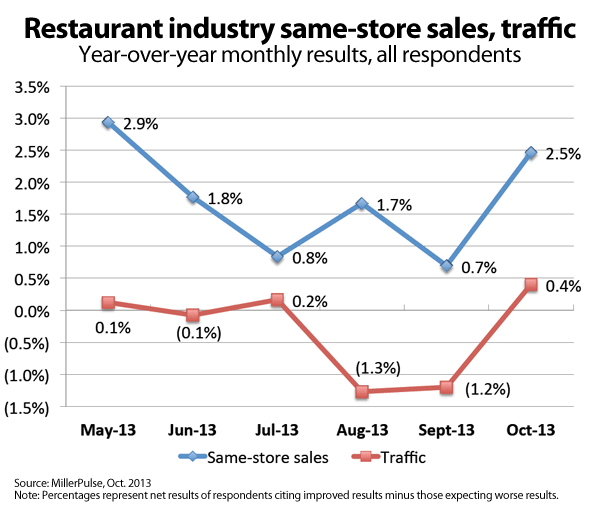Restaurant same-store sales perked up in October, largely on the strength of the fast-food segment, though casual dining had its best month since March 2012, according to the most recent NRN-MillerPulse survey.
Overall industry same-store sales rose 2.5 percent for the month, compared with the prior year, and traffic increased 0.4 percent. However, the trend reflects easier comparisons with last year, when restaurant sales took a hit from Hurricane Sandy on the East Coast.
Still, the improved trends appear to be carrying over into November, the survey found. For the first week of November, same-store sales rose 2.8 percent industrywide, and the outlook is positive as the holiday spending season approaches.
RELATED
• Government shutdown takes toll on restaurant sales, traffic
• Stagnant August restaurant sales dampen operator outlook
• MillerPulse at NRN.com
Larry Miller, a former Wall Street securities analyst and founder and chief executive of the MillerPulse report, declared October “good from far, but far from good.”
Casual-dining same-store sales increased 1.8 percent, which Miller called a “high water mark” for the segment, though gains were largely attributed to easier comparisons. “It’s nice to see that casual dining had the best month in almost a year and a half, but the question is sustainability,” Miller said.
Casual-dining traffic declined 0.8 percent in October, marking the 19th consecutive month of negative traffic trends for the segment. On a two-year basis, casual-dining same-store sales dropped 0.4 percent.

The quick-service segment continued to lead the way, with same-store sales in October rising 3.7 percent, including a 1.2-percent increase in traffic. Fast-casual restaurant same-store sales rose 1.1 percent, while traffic remained flat. Fine-dining restaurants saw same-store sales grow 5.3 percent for the month, an upswing from the 0.8-percent decline in September.
Challenges ahead for food, labor costs
Looking forward to 2014, surveyed operators forecast labor cost inflation of 2.6 percent industrywide, largely as a result of minimum wage hikes in some states and the costs of complying with impending federal healthcare mandates.

Casual dining will likely see labor costs rise 3.1 percent, while such costs will increase 2.1 percent for fast food and 2.3 percent for fast casual, the survey projected. “With labor cost running just under 30 percent of sales for the industry, this rate of labor inflation could be offset with about 75 basis points of menu price,” the report said.
Over the next six months, operators projected that commodity inflation would rise a more moderate 1.8 percent, compared with the 2-percent increase they reported in September.
Operators are most concerned about beef prices over the next six months, with steak prices expected to climb 2.9 percent and ground beef 2.5 percent.
Partly in response to rising commodity costs, menu prices are expected to increase about 1.9 percent over the next six months, with quick-service companies — which include fast-food and fast-casual concepts — raising prices a projected 1.7 percent, and full service restaurants increasing prices 2.2 percent.
The modest climb in menu prices indicates that restaurant operators may not be as concerned about traffic as they have been, said Miller.
Job growth, improvements in the housing market, and lower gas prices are expected to ease the stranglehold on consumer wallets, but consumer confidence slipped to a 16-month low in October, likely because of continued political turmoil, the survey found.
“People are still cautious about spending, though it’s a little better than last month,” said Miller. “It’s ability versus willingness. Jobs put money in their pockets, which makes them able. The question remains whether they are willing” to spend on dining out.
Restaurant chains and operators looking to participate in the MillerPulse survey for additional results and insights can register at millerpulse.com.
Contact Lisa Jennings at [email protected].
Follow her on Twitter: @livetodineout





